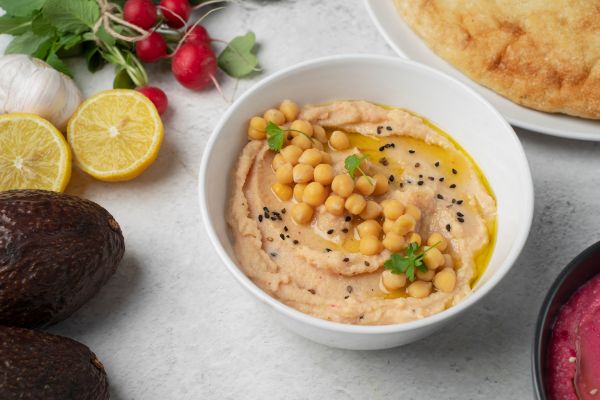Table of Contents
Let’s start …
Hummus, the creamy and flavorful dip loved by millions, has become a global sensation. Its smooth texture, nutty taste, and versatility make it a favorite among food enthusiasts. But have you ever wondered about the origins and health benefits of this delectable Middle Eastern delight?
It is a dip made from cooked and mashed chickpeas, blended with tahini (sesame seed paste), olive oil, lemon juice, and garlic. It has gained immense popularity not only in the Middle East but also in other parts of the world due to its rich flavors and nutritional value.
In this blog post, we will delve into the intriguing history, explore the essential ingredients, uncover the health benefits, and showcase popular variations of hummus that will leave you craving for more.

The History
Ancient origins in the Middle East:
Hummus traces its roots back to ancient civilizations in the Middle East, where it was a staple food. The exact origins are debated, but it is believed to have been consumed as early as the 13th century. It was predominantly enjoyed in countries like Lebanon, Israel, and Egypt.
Cultural significance in the Mediterranean region:
It holds a significant place in Mediterranean cuisine and culture. It has been a symbol of hospitality and is often shared during communal meals. In some countries, such as Lebanon, there are even hummus-making competitions that celebrate this beloved dish.
Spread of hummus to other parts of the world:
In recent decades, this popular dip has transcended regional boundaries and gained widespread popularity. It has become a staple in many international cuisines, thanks to globalization and the increasing appreciation for diverse flavors. Today, you can find it in supermarkets, restaurants, and even homemade versions in kitchens worldwide.
The Ingredients
Primary ingredients: chickpeas, tahini, olive oil, lemon juice, garlic:
Hummus is primarily composed of nutrient-rich ingredients. Chickpeas, also known as garbanzo beans, form the base of this creamy dip. Tahini, a paste made from ground sesame seeds, adds a distinct nutty flavor. Olive oil, lemon juice, and garlic complement the chickpeas and tahini, providing tanginess and depth of taste.
Optional ingredients and variations: roasted red pepper, sun-dried tomatoes, spices, herbs:
While the classic recipe remains a favorite, there are numerous ways to customize and experiment with flavors. Variations like roasted red pepper hummus and sun-dried tomato hummus add a delightful twist with their unique sweet and savory notes. Additionally, spices and herbs like cumin, paprika, and parsley can be incorporated to create exciting flavor profiles.
Importance of quality ingredients for the best-tasting:
To ensure a truly delicious experience, it’s essential to use high-quality ingredients. Freshly cooked or canned chickpeas, authentic tahini, extra virgin olive oil, and freshly squeezed lemon juice can elevate the taste and texture of your homemade hummus.
The Health Benefits
Nutritional profile: high in protein, fiber, and healthy fats:
It is not only a delightful treat for your taste buds but also a nutritious addition to your diet. It is packed with protein from the chickpeas and tahini, making it an excellent plant-based protein source. Furthermore, the fiber content promotes healthy digestion, while the presence of healthy fats, primarily from olive oil and tahini, offers benefits for heart health.
Health benefits of chickpeas and tahini:
Chickpeas, the star ingredient of hummus, are rich in vitamins, minerals, and antioxidants. They contribute to improved digestion, weight management, and blood sugar regulation. Tahini, on the other hand, provides essential minerals like calcium and iron, and its healthy fats are beneficial for brain function and overall well-being.
Role of hummus in a balanced diet and potential weight management benefits:
Incorporating this delicacy into your diet can be a wise choice for weight management and overall health. Its combination of protein, fiber, and healthy fats helps promote satiety, which may reduce overeating and support weight loss efforts. Additionally, it can be a nutritious alternative to high-calorie dips and spreads.
Popular Variations
Classic hummus recipe and its versatility:
The classic recipe serves as a versatile base for various flavor variations. Its creamy and mild taste makes it an excellent canvas for additional ingredients and spices. Whether you enjoy it as a simple dip or use it as a spread in sandwiches and wraps, classic hummus never fails to satisfy.
Roasted red pepper hummus: a tangy and slightly sweet variation:
Roasted red pepper hommus infuses the dip with a tangy and slightly sweet flavor. The smoky notes from the roasted peppers add depth, making it a popular choice among its enthusiasts. It pairs exceptionally well with grilled vegetables or as a topping for bruschetta.
Sun-dried tomato hummus: a flavorful and savory twist:
Sun-dried tomato hummus offers a burst of rich, savory flavors. The sun-dried tomatoes contribute an intense umami taste, complemented by the creaminess of the chickpeas and tahini. Spread it on toasted bread or use it as a dip for vegetable crudités for a delightful snacking experience.
Other variations with spinach and artichoke, avocado, black bean:
The world of hummus variations is virtually limitless. Other exciting options include spinach and artichoke , which combines the classic dip with the flavors of these popular Mediterranean ingredients. Avocado adds a creamy and velvety texture, while black bean hommus offers a delightful twist with its earthy taste and enhanced fiber content.
Serving and Enjoying
Traditional ways of serving: as a dip, spread, or part of a mezze platter:
It offers endless possibilities when it comes to serving and enjoying it. Traditionally, it is served as a dip alongside fresh pita bread, crisp vegetables like carrots and cucumbers, or crunchy pita chips. It can also be used as a spread in sandwiches and wraps, adding a creamy and flavorful element. Additionally, hummus finds its place in a mezze platter, alongside other Middle Eastern delights like falafel, tabbouleh, and olives.
Pairing suggestions: pita bread, vegetables, crackers, chips:
When serving hommus, it’s important to choose the right accompaniments to enhance the overall experience. Freshly baked or toasted pita bread is a classic choice, as its soft texture complements the creamy dip. Vegetables like bell peppers, cherry tomatoes, and celery add a refreshing crunch. For those seeking a bit of a crunch, crackers and chips provide a satisfying contrast in texture.
Creative uses in recipes: hummus-stuffed chicken, hummus salad dressings, hummus-based sauces:
It goes beyond being a dip or spread and can be used in various creative ways in your culinary adventures. Stuffing chicken breasts with it and baking them creates a flavorful and moist dish. Mixing it with lemon juice and olive oil can result in a delicious salad dressing. It can also serve as a base for flavorful sauces to accompany roasted vegetables or grilled meats.
Tips for Making Homemade Hummus
Step-by-step guide to making hummus from scratch:
Making hummus from scratch is a rewarding experience that allows you to customize the flavors to your liking. Begin by cooking the chickpeas until tender, then blend them with tahini, olive oil, lemon juice, garlic, and seasonings. Adjust the consistency by adding water or more olive oil as desired. Experimenting with ingredient proportions and additional flavors can help you create your signature recipe.
Experimenting with flavors and ingredients to create unique homemade hummus:
One of the joys of making homemade hummus is the freedom to experiment with flavors and ingredients. Add roasted garlic, herbs like cilantro or basil, or spices like cumin or paprika to infuse your dish with unique tastes. Be bold and creative, and you might discover a new favorite hommus variation.
Reiteration of the popularity and versatility of hummus:
This dish has truly captured the hearts and taste buds of people worldwide. Its popularity continues to soar, thanks to its delightful flavors, nutritional benefits, and versatility in various culinary creations. Whether enjoyed as a simple dip, a tangy roasted red pepper variation, or in unique recipes, it remains a beloved and versatile culinary delight.
Encouragement for readers to try making and enjoying hommus in various ways: If you haven’t yet experienced the joy of hommus, it’s time to dive in and explore its wonders. Whether you choose to sample different store-bought variations or embark on the adventure of making your own homemade hommus, there are countless opportunities to indulge in this creamy, flavorful dip. So grab some pita bread, gather your favorite vegetables, and prepare to savor the delights of hommus in all its glory.

